Difference between revisions of "GRIN Lens Information"
| Line 12: | Line 12: | ||
**People have experienced supply issues from some suppliers (discussed below) | **People have experienced supply issues from some suppliers (discussed below) | ||
== GRIN Lens Optics == | == GRIN Lens Optics == | ||
| − | + | A nice overview of GRIN optics can be found on [[https://en.wikipedia.org/wiki/Gradient-index_optics|wikipedia]] and [[http://www.grintech.de/gradient-index-optics.html|Grintech.de]]. The most common use for GRIN lenses is for fiber coupling and light collimation and focusing. Aside from Grintech, all other GRIN lens manufacturers appear to produce GRIN lenses mainly for this use and not specifically for imaging. The index of refraction profile for most commercial GRIN lenses follow a second order expansion of a hyperbolic secant curve. The second order expansion (a parabola) is the ideal profile for on axis focusing of collimated light but has focusing issues of off axis light. Grintech uses an additional manufacturing step to add the forth order expansion term of the hyperbolic secant to their index of refraction profile. The forth order term improves off axis focusing which is very important for imaging applications. Theoretically there is not an ideal index of refraction profile for an imaging GRIN lens but the 4th order expansion term does a good enough job for imaging in our system. | |
== GRIN Lens Issues == | == GRIN Lens Issues == | ||
== GRIN Lens Suppliers == | == GRIN Lens Suppliers == | ||
Revision as of 20:52, 7 January 2016
GRadient INdex (GRIN) lenses use a non uniform index of refraction to shape light instead of surface curvature as with standard lenses. Our system uses a cylindrical GRIN lens which is implanted within 200um of the structure of interest. For a given GRIN lens, its focusing property can be adjusted by changing the pitch of the lens which is directly related to the lens length.
- Advantages of GRIN lenses
- Extremely small to zero working distance
- Optical properties tune-able by changing lens length
- Affordable
- Small size (down to 0.5mm in diameter)
- Compatible
- Disadvantages of GRIN lenses
- No optimal index of refraction profile for imaging applications
- The majority of commercially available GRIN lenses are not optimized for imaging applications (discussed below)
- People have experienced supply issues from some suppliers (discussed below)
GRIN Lens Optics
A nice overview of GRIN optics can be found on [[1]] and [[2]]. The most common use for GRIN lenses is for fiber coupling and light collimation and focusing. Aside from Grintech, all other GRIN lens manufacturers appear to produce GRIN lenses mainly for this use and not specifically for imaging. The index of refraction profile for most commercial GRIN lenses follow a second order expansion of a hyperbolic secant curve. The second order expansion (a parabola) is the ideal profile for on axis focusing of collimated light but has focusing issues of off axis light. Grintech uses an additional manufacturing step to add the forth order expansion term of the hyperbolic secant to their index of refraction profile. The forth order term improves off axis focusing which is very important for imaging applications. Theoretically there is not an ideal index of refraction profile for an imaging GRIN lens but the 4th order expansion term does a good enough job for imaging in our system.
